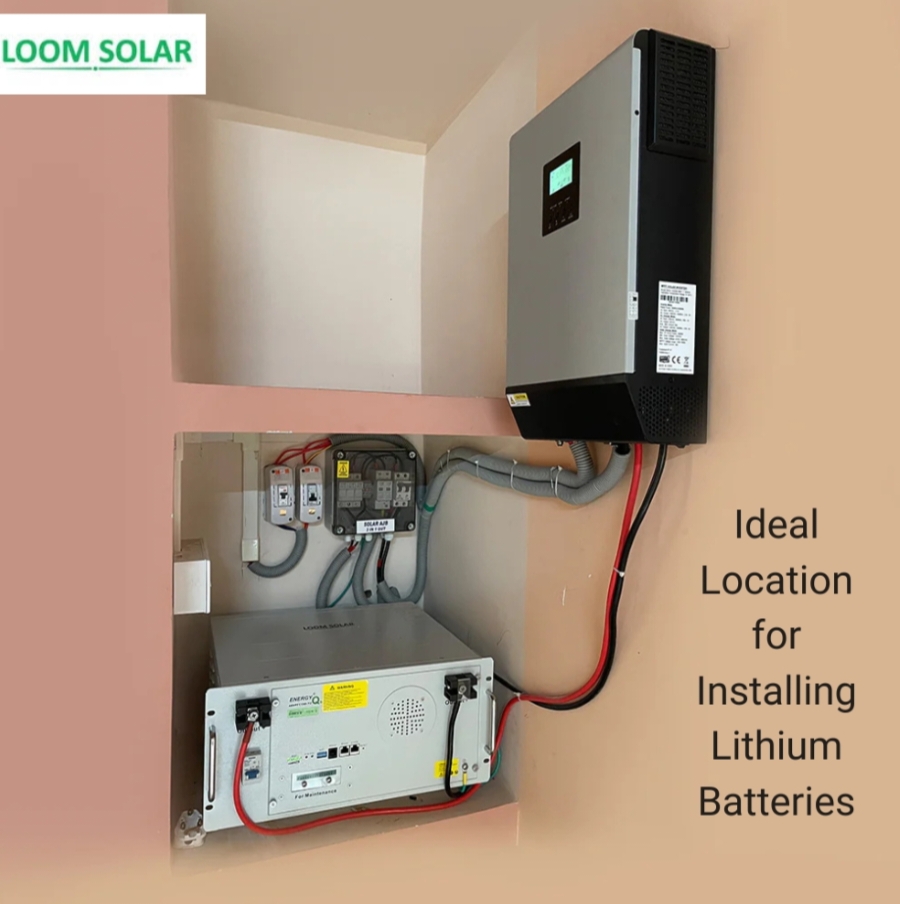As Indian families increasingly adopt renewable energy solutions such as Home solar system and advanced inverters, lithium batteries are becoming the preferred choice for energy storage. They are lighter, more efficient, and longer-lasting compared to traditional lead-acid batteries. However, to get the best performance and maximum lifespan from a lithium battery, proper installation is crucial. Unlike lead-acid batteries, lithium batteries come with their own set of unique requirements and precautions.
This blog will guide you on the ideal location for installing lithium batteries at home and highlight special considerations that apply specifically to lithium technology.
Why Installation Location Matters
The installation location of a battery directly impacts its efficiency, safety, and life cycle. Even the most advanced lithium battery can underperform or face premature wear if placed in the wrong environment. For example, exposure to excessive heat, poor ventilation, or moisture can reduce its efficiency and compromise safety.
By choosing the right location, families can ensure:
• Better safety for the household
• Higher energy efficiency
• Longer battery lifespan
• Minimal maintenance issues
General Location Guidelines
1. Dry and Well-Ventilated Area
Lithium batteries should always be installed in a dry space, away from moisture or water leakage points. Unlike lead-acid batteries, lithium models don’t emit gases during charging, but ventilation is still necessary to avoid overheating.
2. Away from Direct Sunlight and Heat Sources
Overheating shortens the life of lithium batteries and decreases their efficiency. Batteries shouldn’t be placed on rooftops in direct sunlight or next to stoves, ovens, or geysers. It is best to have a temperature-controlled, shaded space.
3. Stable Surface and Secure Mounting
Because lithium batteries are smaller and lighter than lead-acid batteries, they can be installed on shelves or mounted on walls. To avoid unintentional damage, always make sure they are fixed on a level, vibration-free surface.
Special Information Unique to Lithium Batteries
Lithium batteries have more sophisticated technology than lead-acid batteries, however there are a few things to keep in mind:
1. Battery Management System (BMS) Access
° Every lithium battery is equipped with a Battery Management System (BMS) that regulates charging, discharging, and temperature.
° When installing, ensure the location allows easy access to monitoring ports or display panels. This helps homeowners track performance, efficiency, and any fault alerts.
° Lead-acid batteries don’t have BMS, so this step is unique to lithium technology.
2. Temperature Sensitivity
° Lithium batteries are highly sensitive to extreme temperatures compared to lead-acid.
° They operate best between 20°C to 30°C. Installing them in garages or outdoor sheds without insulation may expose them to excessive cold in winters or heat in summers.
° Unlike lead-acid, lithium batteries may even shut down charging automatically if the temperature goes below 0°C or rises above 45°C. This is a protective feature but must be kept in mind during installation.
3. Wall-Mounting Options
° Lithium batteries are compact and lightweight, often designed for wall-mount installations to save space.
° When wall mounting, ensure the wall is strong enough and the battery is positioned with adequate air clearance around it for cooling.
° Lead-acid batteries cannot be wall-mounted and must always be placed on the ground.
4. No Acid Spillage Concerns
° Unlike lead-acid, lithium batteries do not contain liquid electrolytes that can spill.
° This allows homeowners more flexibility in choosing locations even indoors near living areas as long as the room is well-ventilated and temperature controlled.
5. Integration with Smart Systems
° Many lithium batteries allow integration with apps or smart monitoring systems.
° During installation, provide space for Wi-Fi or Bluetooth connectivity so homeowners can monitor performance remotely.
° Lead-acid systems generally lack this capability, so installation for them does not require connectivity planning.
Locations to Avoid
• Near bathrooms, kitchens, or water tanks (risk of moisture damage)
• In attics or rooftops exposed to high summer heat
• Inside closed boxes or tight cupboards without ventilation
• Next to flammable items like kerosene, petrol, or LPG cylinders
Ideal Locations at Home
• Utility Room or Storeroom: Cool, dry, and away from daily movement.
• Dedicated Battery Cabinet: With ventilation holes and temperature stability.
• Living Room Corner (for wall-mount models): Safe and space-saving, especially in modern apartments.
• Garage (with insulation): Suitable if temperature is kept within safe operating range.
Conclusion
Installing lithium batteries at home requires careful planning, and the right location plays a vital role in performance and safety. While lead-acid batteries are bulky, emit gases, and need open spaces, lithium batteries offer flexibility with wall-mounting, compact size, and indoor placement. However, homeowners must consider additional factors like temperature sensitivity, access to the BMS, and smart monitoring options features unique to lithium batteries.



